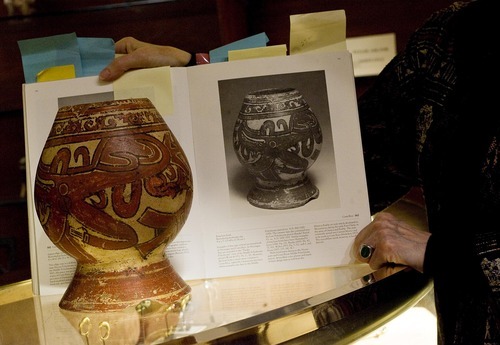This is an archived article that was published on sltrib.com in 2010, and information in the article may be outdated. It is provided only for personal research purposes and may not be reprinted.
San Francisco • A handwritten card dangling from the schist Buddha's wrist meticulously tracks its known wanderings through the world.
"Dr. J.R. Belmont collection," it reads, noting that the earliest documented owner of this cross-legged Ghandaran statue from the second or third century. "Acquired 1976."
"Exb: Museum Rietberg Zurich," it says, noting a 1987 exhibition and a companion publication with photo, "pg. 64."
To the casual observer, it's all footnote minutiae. But if you're the one forking over $168,000 for this child-size Afghan beauty, you might want to know that the seller has a right to sell it.
"Provenance," it's called, both for fine arts and for antiquities, and, true to those spheres, it's a craft that shares none of the bureaucratic conventions of a car title or birth certificate.
"Anybody can say anything," Xanadu Gallery owner Marsha Vargas Handley said about provenance.
It's important to document the trail as far back as possible, she said, and published photos are best.
Besides indicating legal possession, documentation helps protect against buying a modern knockoff.
Xanadu is off Union Square, a couple of blocks below Chinatown's Dragon Gate, and Vargas Handley specializes in Asian art. But also on the shelves of her Frank Lloyd Wright-designed gallery — and on basement racks — are pre-Columbian pots from a collection she bought in 2002.
The Lewis K. Land Collection, to be precise. You can look up that late San Francisco collector's stuff in books from museums, and you can do it right here on Vargas Handley's glass counter, flipping to the pages with Post-it notes marking her pieces.
Provenance is old-school math done on fingers, not Excel. A picture book and a bill of sale can add up to buyer security, but there's little certainty going back through the centuries. No one really knows who gathered the Buddha from the Afghan-Pakistani frontier, or exactly where.
International treaties adopted in the late 20th century now demand precise documentation of newly discovered artifacts. But for most older finds, there's no 1040EZ of antiquity. If you're lucky, there's something like Fire, Earth and Water: Sculpture From the Land Collection of Mesoamerican Art, with a picture of your Mayan alligator-motif pot and the names of every link in the ownership chain since Kennedy, if not since Cortez.
"This is what's invaluable," Vargas Handley says, lining up her ancient Costa Rican pot and a visible crack to the same angle as the shot in the book. "There it is."





